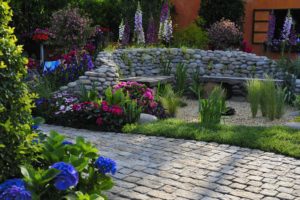Gardening is a source of endless delight. Whether you’re envisioning a lush vegetable garden or a vibrant flower oasis, crafting your garden in your yard can be a deeply fulfilling journey.
In this article, we’ll explore ten easy steps to get you started on your gardening adventure.

Step 1: Define Your Garden Goals
Before you start, consider your garden’s purpose. Do you aspire to cultivate a thriving vegetable garden, a fragrant herb paradise, or a colorful flower haven? If you choose to grow edibles, select those your family enjoys. For flowers, decide between annuals for a season of vibrant blooms or perennials for year-after-year beauty. Starting small until you’re more comfortable with the process is sound advice.
Step 2: Pick the Best Garden Spot
Almost all plants require ample sunlight to flourish. Spend some time observing your yard to identify spots that receive 6-8 hours of direct sunlight per day. A sunny location is crucial for vegetables and most flowers. If you have shady areas, opt for shade-tolerant plants like hostas and ferns. Additionally, ensure your garden has easy access to a water source for hassle-free watering.
Step 3: Clear the Ground
Prepare your garden area by removing weeds and sod. For a quick transformation, cut out the sod using a spade and divide it into sections for easy removal. If you have more time, consider the lasagna gardening method. Cover your garden with five sheets of newspaper, followed by a 3-inch layer of compost or a mixture of potting soil and topsoil. After about four months, the compost and paper will decompose, leaving you with a weed-free and fertile planting bed.
Step 4: Test and Improve Your Soil
Before planting, have your soil tested through your local cooperative extension office. The results will reveal your soil’s nutrient content and deficiencies, guiding you on how to improve it. In most cases, you’ll need to enrich your soil with organic matter like compost. Spread a 2-3 inch layer of compost and allow it to work its magic with the help of earthworms, improving your soil’s structure.
Step 5: Prepare Your Planting Beds
Loosen the soil in your prepared beds before planting to facilitate root growth and nutrient absorption. This can be done through tilling with a rototiller or by hand with a spade or fork. Timing is crucial – the soil should be moist enough to form a loose ball but dry enough to fall apart when dropped. Mix in the organic matter from step 4 during this process, taking care not to overdo it or compact the soil.
Step 6: Create Garden Beds and Pathways
After preparing your planting beds, define your garden layout. Use edging materials to create clear bed boundaries and prevent encroaching weeds. Consider incorporating pathways made of gravel, stepping stones, or mulch to navigate your garden without disturbing the soil. Thoughtful pathways enhance both accessibility and aesthetics.
Step 7: Select the Right Tools
Equipping yourself with the appropriate tools is essential for efficient gardening. Basic tools such as a hand trowel, gloves, weeder, rake, and pruners will aid in planting, weeding, and pruning. Invest in high-quality, durable tools and maintain them for a smooth gardening experience.
Step 8: Plan for Proper Watering
Watering is a critical aspect of garden care. Consider installing a drip irrigation system or soaker hoses to provide direct root-zone watering, reducing water waste and minimizing disease risks. Develop a watering schedule and stick to it to ensure your garden thrives.
Step 9: Implement Pest Control and Companion Planting
To protect your garden from pests and promote plant health, utilize natural pest control methods like introducing beneficial insects, setting up traps, and using organic pesticides sparingly. Companion planting is another strategy; pair plants that benefit one another, discouraging pests and enhancing growth. For instance, planting marigolds alongside your vegetables can deter harmful nematodes.
Step 10: Keep Learning and Enjoy the Journey
Gardening is an ongoing learning experience. Read, watch, attend workshops, and consult with seasoned gardeners. Visit local botanical gardens and relish the ever-deepening connection to nature. Gardening is not just a hobby; it’s a lifelong journey of discovery, offering a deeper understanding of the natural world and a profound sense of accomplishment as your garden thrives.

Creating a garden in your yard is a delightful journey of growth and beauty. By considering your goals, selecting the right spot, clearing the ground, improving your soil, preparing planting beds, creating defined beds and pathways, selecting the right tools, watering efficiently, implementing pest control, and constantly learning, you’re on your way to a flourishing garden. Your home garden will be a testament to your love for the natural world, providing a serene sanctuary and a source of pride. So, let the garden journey begin, and may it be a lifelong adventure filled with the beauty of nature and the joy of growing your own piece of paradise.
To delve more, please don’t hesitate to visit Top 20 Outdoor Living Room Ideas for Al Fresco Entertaining for more ideas.


